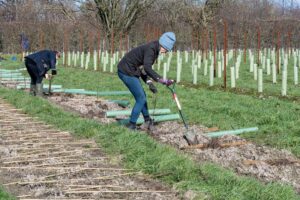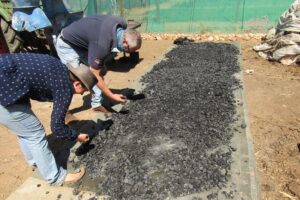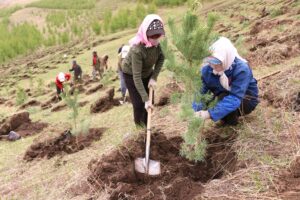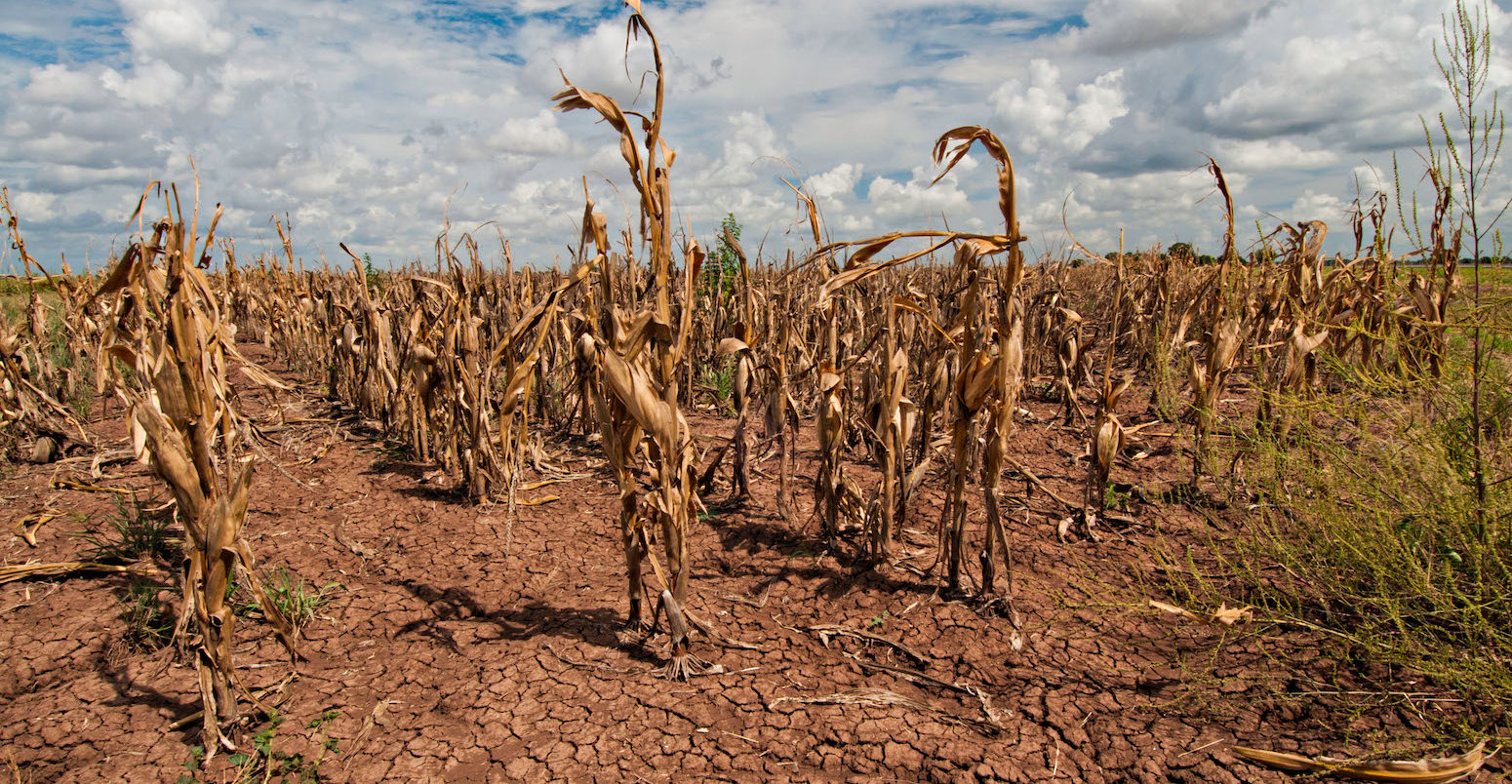
Falling crop yields under warming could see ‘rapid’ decline in bioenergy’s potential
Ayesha Tandon
09.07.22Ayesha Tandon
07.09.2022 | 4:54pmThe impact of global warming on crop yields could reduce the effectiveness of bioenergy with carbon capture and storage – a technology often touted as key for meeting the Paris Agreement warming limits, new research finds.
Bioenergy with carbon capture and storage (BECCS) involves burning biomass for energy and capturing the resulting emissions. This controversial “negative emissions” technology is currently restricted to a few pilot projects, but features heavily in model pathways that limit global warming to 1.5C or 2C above pre-industrial temperatures.
The new research, published in Nature, assumes that biofuels and residues from food crops are both used for BECCS. The authors find that as global temperatures rise, crop yields will decline, resulting in reduced residues. This will limit the efficiency of BECCS, reducing the ability of the technology to remove emissions from the atmosphere.
The study finds that if the warming is allowed to cross a “threshold” of 2.5C warming, the effectiveness of BECCS could “rapidly decrease”. This could make it impossible to use BECCS to push global warming back below 2C, the authors find.
The research shows that models which rely on BECCS to limit global temperature rise “could be unduly optimistic”, says an accompanying commentary. The analysis “demonstrates convincingly” that “waiting for salvation could well hasten our demise, because delays might restrict the technologies available to us now”, it adds.
The paper also warns of food insecurity as crop yields fall. Developing countries – which often see the most severe impacts of warming – will be among the first to be affected. This reinforces the urgency of early climate mitigation “to avoid irreversible climate change and serious food crises”, the study adds.
Bioenergy
To meet the warming limits set out in the Paris Agreement, most emissions scenarios rely heavily on negative emissions technologies to remove carbon from the atmosphere later in the century, as well as rapid decarbonisation in the near term.
Bioenergy with carbon capture and storage (BECCS) is one such technology. It involves burning biomass – from agricultural waste and/or growing dedicated bioenergy crops – to produce energy, and capturing the resulting emissions for long-term storage.
In the latest Intergovernmental Panel on Climate Change report on climate change mitigation, all pathways that limit global warming to 1.5C or 2C rely on land-based CO2 removal methods – such as tree planting and BECCS – to some extent. The report estimates that large-scale BECCS could remove 5.9bn tonnes of CO2 equivalent (GtCO2e) each year over 2020-50. However, it adds that the technology has sparked “fervent debate” in recent years.
BECCS is currently only operational in a handful of pilot projects and will need to be scaled up to notably reduce atmospheric CO2 levels. It is often touted as a way to produce carbon neutral energy from food waste. But in practice, scaling up the technology could require setting aside vast areas of land to grow bioenergy crops – possibly reducing the amount of land available to grow food for human consumption.
Prof Rong Wang from Fudan University is an author on the new study. He tells Carbon Brief that the paper focuses on “scenarios where food crops are increased globally to ensure food security before using the limited land to grow the dedicated energy crops”.
The study assumes that cropland will expand – converted from forests or marginal lands – to help feed a growing global population. It further assumes that half of this land is used to grow new energy crops and the other half is used for food crops with the residues given over to BECCS.
The study reveals a potential flaw with reliance on BECCS – the impact of global warming on crop yields. The authors explore the optimal growing conditions for wheat, rice and maize – key crops whose residues could be used for BECCS – by looking at crop growth data from 13 countries distributed across the globe.
They find that crops achieve optimal growth when average temperatures during the growing season are around 25C, but that yield drops off quickly at higher temperatures. CO2 fertilisation – in which higher atmospheric CO2 levels aid plant growth – partly counteracts this effect, as does an increase in soil nitrogen levels.
Overall, the authors conclude that temperature is the more significant driver of crop yields, which will drop as the climate warms. This means that the later BECCS is implemented, the less effective it will be, creating a “feedback loop”, the authors warn.
A News & Views article that accompanies the study – penned by Dr Gernot Wagner, a climate economist at Columbia Business School, and Prof Wolfram Schlenker from Columbia University – neatly summarises this finding:
“Timing is a crucial factor: the longer we wait before implementing BECCS on a large scale, the more negative will be the impact of climate on crop yields – worsening climate change still further.”
Feedback loop
To determine the impact of this feedback loop on future warming, the authors investigate how global temperatures would evolve between the present day and 2200, if widespread mitigation and BECCS were implemented from 2040, 2050 or 2060.
They use the OSCAR Earth system model – calibrated with results from the fifth and sixth phases of the Coupled Model Intercomparison Project – to determine interactions between climate change and the global carbon cycle. Average growing-season temperatures for maize, rice and wheat were estimated by country based on global crop calendar data.
The paper projects a very high emissions scenario (SSP5-8.5) until mitigation and BECCS are implemented, after which emissions drop to meet current emissions pledges in a moderate warming scenario (SSP2-4.5).
The authors also include two different BECCS responses – one excluding the agricultural “feedback loop” – and the other including it. The figure below, from the News & Views article, shows these results.
The dotted lines show the model runs without the agricultural feedback loop, while the solid lines show model runs including the feedback loop. The red, blue and yellow lines indicate the implementation of mitigation and BECCS from 2040, 2050 and 2060, respectively.
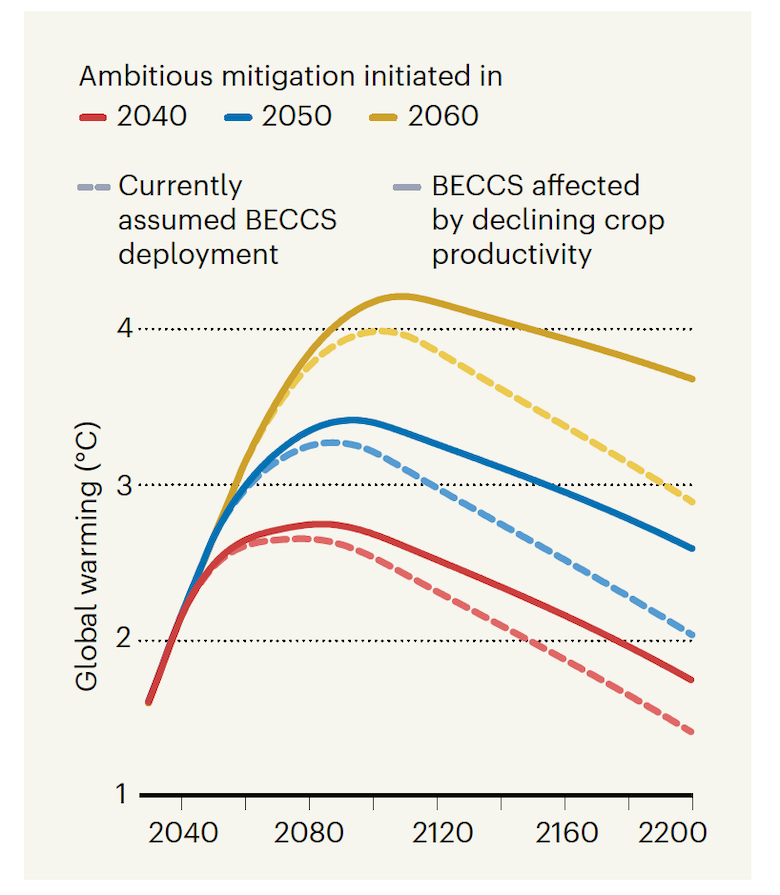
The authors find that including the feedback loop reduces the efficiency of BECCS, resulting in greater warming for the same amount of BECCS. A key factor is a “climate threshold” of 2.5C, above which “the yields of agricultural residues for BECCS would be too low to meet the Paris goal of 2C by 2200”, the study says.
The findings highlight the concerns of overshooting temperature limits and “relying solely on BECCS” to bring global temperatures back down, the paper says, adding that this approach assumes that BECCS production remains “insensitive to climate change”.
Wang tells Carbon Brief that the work “substantially undermines the feasibility of high allowable fossil-fuel emissions in the overshoot scenarios of delayed mitigation, which deserves attention and more studies”.
Meanwhile, Dr Andy Wiltshire – research manager of the Terrestrial Carbon Cycle group at the UK Met Office, who was not involved in the study – tells Carbon Brief that the paper “highlights the increasing level of risk that comes from reliance on technological options that may be directly impacted by climate change in unforeseen ways”.
And the News & Views piece concludes:
“[The study has] offered further evidence that relying on technological breakthroughs down the line is a fraught endeavour. As their analysis demonstrates convincingly, waiting for salvation could well hasten our demise, because delays might restrict the technologies available to us now.”
Food crisis
Declining crop yields will also impact food security, the paper says. Many countries – especially developing countries located at lower latitudes – are likely to see food insecurity as a result of declining crop yields.
The authors assess future food insecurity using a value called the “food gap” – which compares the average number of calories available per person per day in different countries to the recommended daily number.
The map below shows the global “food gap” in 2100, if large-scale mitigation and BECCS are implemented from 2040. A positive food gap (red) indicates a deficit of calories, while a negative value (blue) indicates a surplus. In this scenario, global warming would reach 2.5C by 2050 and 2.7C by 2100.
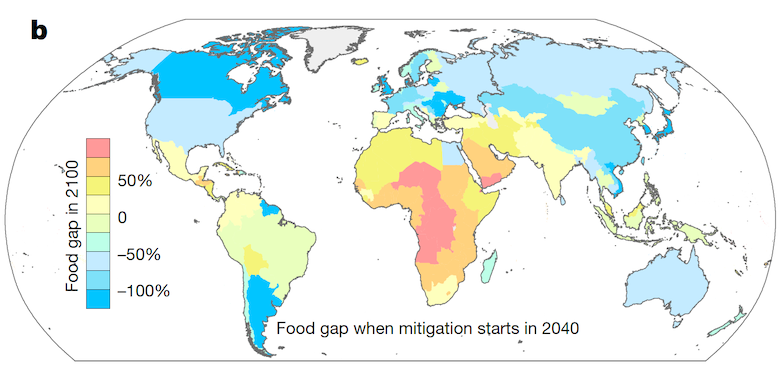
The map shows that while most developed countries will have a surplus of food, many developing countries – especially in Africa – will face food shortages. The authors find that crossing the 2.5C warming threshold would “jeopardise food security in most developing countries, with a potential impact on developed countries”.
Delaying mitigation until 2060 would worsen food insecurity worldwide. The number of developing countries with a positive food gap would rise from 81 to 90, according to the study. Meanwhile, the food gap in India, Africa and the Middle East would rise above 50%, if there were no food trade to supplement crops grown regionally.
Wang tells Carbon Brief that the analysis probably underestimates future crop yields, as it does not include benefits from technological advances. However, he adds that the damaging impacts of extreme weather events – such as heat extremes or floods – are also not accounted for, which could counteract this effect.
Meanwhile, Dr Joana Portugal Pereira – a research fellow at the Federal University of Rio de Janeiro, who was not involved in the research – highlights that CO2 fertilisation can cause the “dilution of nutrient density” in crops. This implies that even those getting the recommended daily amount of calories may receive fewer nutrients from their food.
The trade-off between using land to grow food and to grow bioenergy crops is a divisive issue. The News & Views article says:
“The many competing interests for limited land – with food chief among them – impose severe constraints on the likelihood that it can be scaled up as much as is sometimes assumed.”
Dr Naomi Vaughan is a senior lecturer in climate change at the University of East Anglia, and was not involved in the study. She tells Carbon Brief that when sourced sustainably, BECCS “has a potentially valuable role in addressing hard-to-abate emissions and longer-term net negative global emissions, along with other forms of carbon removal”.
Prof Felix Creutzig – head of the working group on land use, infrastructures and transport at the Mercator Research Institute on Global Commons and Climate Change, who is also not involved in the research – says that “expanding BECCS as fast as possible is not warranted”.
Creutzig tells Carbon Brief that “pressure on global land must be reduced” and favours measures including cutting down on red meat production, rather than expanding BECCS, to stay within “planetary boundaries”.
Xu et al (2022), Delayed use of bioenergy crops might threaten climate and food security, Nature, doi:10.1038/s41586-022-05055-8
-
Falling crop yields under warming could see ‘rapid’ decline in bioenergy’s potential


